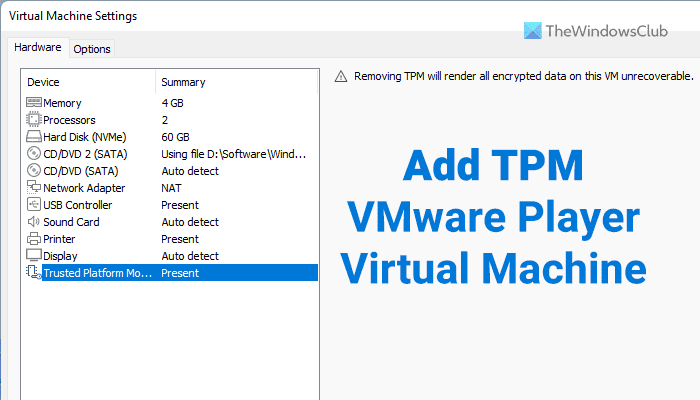It's a shame that VMware flat out refuses to listen to Beta testers. I'll come back to that in a moment.
During the life of VMware Workstation Pro 16, VMware removed the ability to autostart VMs. In other words, you need to logon in order for a VM to be started. Then they brought that feature back and stated that it would remain throughout the life of version 16, only to again remove the feature in a later build!
Now, they have brought it back in version 17 and want to tout it like it's a new feature that you need to pay to upgrade to. However, what they don't tell you is that the autostart feature will not work for encrypted VMs. And of course, they enforce encryption for Win 11 VMs.
They were specifically informed about this shortcoming during the Technology Preview (BETA), noting that Microsoft allows installation with a TPM but refused to acknowledge it. There are workarounds - you can lie to VMware and tell it that you are installation Win 10 which removes those requirements, but it's a shame that they don't listen and allow for that option in the VMware UI.
During the version 16 fiasco, I transitioned all my VMs to Hyper-V and I'm glad I did so.
Now that I've played with VMware Workstation Pro 17 for a bit, I see it as a useless option, at least for me personally.
I'm sure that there are others that may disagree, but I have to say that I'm very disappointed.
During the life of VMware Workstation Pro 16, VMware removed the ability to autostart VMs. In other words, you need to logon in order for a VM to be started. Then they brought that feature back and stated that it would remain throughout the life of version 16, only to again remove the feature in a later build!
Now, they have brought it back in version 17 and want to tout it like it's a new feature that you need to pay to upgrade to. However, what they don't tell you is that the autostart feature will not work for encrypted VMs. And of course, they enforce encryption for Win 11 VMs.
They were specifically informed about this shortcoming during the Technology Preview (BETA), noting that Microsoft allows installation with a TPM but refused to acknowledge it. There are workarounds - you can lie to VMware and tell it that you are installation Win 10 which removes those requirements, but it's a shame that they don't listen and allow for that option in the VMware UI.
During the version 16 fiasco, I transitioned all my VMs to Hyper-V and I'm glad I did so.
Now that I've played with VMware Workstation Pro 17 for a bit, I see it as a useless option, at least for me personally.
I'm sure that there are others that may disagree, but I have to say that I'm very disappointed.
My Computers
System One System Two
-
- OS
- Win11 Pro 23H2
- Computer type
- PC/Desktop
- Manufacturer/Model
- Home Built
- CPU
- Intel i7-11700K
- Motherboard
- ASUS Prime Z590-A
- Memory
- 128GB Crucial Ballistix 3200MHz DRAM
- Graphics Card(s)
- No GPU - CPU graphics only (for now)
- Sound Card
- Realtek (on motherboard)
- Monitor(s) Displays
- HP Envy 32
- Screen Resolution
- 2560 x 1440
- Hard Drives
- 1 x 1TB NVMe Gen 4 x 4 SSD
1 x 2TB NVMe Gen 3 x 4 SSD
2 x 512GB 2.5" SSDs
2 x 8TB HD
- PSU
- Corsair HX850i
- Case
- Corsair iCue 5000X RGB
- Cooling
- Noctua NH-D15 chromax.black cooler + 10 case fans
- Keyboard
- CODE backlit mechanical keyboard
- Mouse
- Logitech MX Master 3
- Internet Speed
- 1Gb Up / 1 Gb Down
- Browser
- Edge
- Antivirus
- Windows Defender
- Other Info
- Additional options installed:
WiFi 6E PCIe adapter
ASUS ThunderboltEX 4 PCIe adapter
-
- Operating System
- Win11 Pro 23H2
- Computer type
- Laptop
- Manufacturer/Model
- Lenovo ThinkBook 13x Gen 2
- CPU
- Intel i7-1255U
- Memory
- 16 GB
- Graphics card(s)
- Intel Iris Xe Graphics
- Sound Card
- Realtek® ALC3306-CG codec
- Monitor(s) Displays
- 13.3-inch IPS Display
- Screen Resolution
- WQXGA (2560 x 1600)
- Hard Drives
- 2 TB 4 x 4 NVMe SSD
- PSU
- USB-C / Thunderbolt 4 Power / Charging
- Mouse
- Buttonless Glass Precision Touchpad
- Keyboard
- Backlit, spill resistant keyboard
- Internet Speed
- 1Gb Up / 1Gb Down
- Browser
- Edge
- Antivirus
- Windows Defender
- Other Info
- WiFi 6e / Bluetooth 5.1 / Facial Recognition / Fingerprint Sensor / ToF (Time of Flight) Human Presence Sensor


















